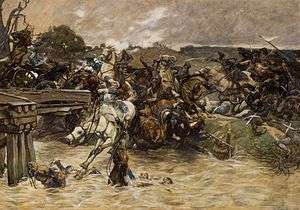Battle of the Katzbach
The Battle of the Katzbach on 26 August 1813, was a major battle of the Napoleonic Wars between the forces of the First French Empire under Marshal MacDonald and a Russo-Prussian army of the Sixth Coalition under Prussian Marshal Graf (Count) von Blücher.[1] It occurred during a heavy thunderstorm at the Katzbach river between Wahlstatt and Liegnitz in the Prussian province of Silesia.[2] With the involvement of more than 200,000 troops, it was one of the largest battles of the Napoleonic Wars. Taking place the same day as the Battle of Dresden, it resulted in a Coalition victory.
| Battle of the Katzbach | |||||||
|---|---|---|---|---|---|---|---|
| Part of War of the Sixth Coalition | |||||||
 Battle of the Katzbach by Eduard Kaempffer. | |||||||
| |||||||
| Belligerents | |||||||
|
|
| ||||||
| Commanders and leaders | |||||||
|
|
| ||||||
| Strength | |||||||
| 114,000 | 102,000 | ||||||
| Casualties and losses | |||||||
| 4,000 killed and wounded |
33,000 13,000 killed and wounded 20,000 captured Two Eagles lost | ||||||
Prelude
Blücher ordered the Army of Silesia to advance on 13 August, before the Truce of Pläswitz could conclude on 17 August. In a series of running fights, the Allied army beat back the confused French, who did not anticipate that the Allies would break the armistice so brazenly.[3] These minor victories raised the morale of the inexperienced German levies.[4] On the first day, Blücher and his chief of staff August Neidhardt von Gneisenau became separated and did not issue orders for troop movements until late in the day, slowing down the Allied advance.[4] The French resistance grew in intensity, the Allied night marches multiplied owing to constant combat and delays, and the weather turned atrocious. On 20 August, Blücher's men came face-to-face Napoleon's main army at the Bober river and beat a hasty retreat when the cheers of the French troops announced the arrival of the French emperor.[4]
For the next five days, the Silesian Army engaged in a series of fierce and costly rearguard actions against the pursuing French forces, which were personally commanded by Napoleon.[4] Blücher's army began to fall apart.[4] The Landwehr militiamen deserted en masse, while the Allied corps commanders complained of the ruin befalling their army thanks to the incompetence of its general staff.[5] Blücher contemplated firing Gneisenau.[5]
When Blücher on 24 August learned that Napoleon was no longer in direct command of the pursuers, he turned his army around to face the enemy and ordered his men to march to the Katzbach river.[5] Jacques MacDonald's Army of the Bober would meet him in a major battle there on 26 August.[5] MacDonald was ordered by Napoleon to advance east on 25 August to the town of Jauer and assume defensive positions, but could not move for 24 hours owing to Napoleon's poorly-worded order that sent Marshal Michel Ney's 50,000-strong, three-division III Corps the wrong way.[5] Valuable time was lost before the error was rectified.[5]
Battle

The two armies, each with more than 100,000 men, stumbled upon one another after MacDonald crossed the swollen river. A sudden flood cut away many of the bridges and destroyed the fords.[6] In the midst of the confusion and heavy rain, MacDonald seemed to recover first. Although his orders were to defend the flank of Napoleon's main force from Blücher, MacDonald decided to attack. He dispatched two-thirds of his army, about 60,000 men, in an attempt to flank the Russo-Prussian right. But confusion reigned again as the French columns found themselves too far apart to support one another.
Blücher ordered his right-wing to advance.[6] The muskets were too wet for firing and the battle was decided with cold steel.[6] The remaining 30,000 men of MacDonald's force, who were supposed to hold down the Coalition forces, were met by a heavy counter-attack by Prussian cavalry. Without support or reinforcement, the French were crushed by the fanatical Prussian soldiers who stabbed them to death with their bayonets and pushed them into the river.[6] The remnants of MacDonald's army retreated, with thousands drowning in the Katzbach and the Raging Neisse which were in spate.
Aftermath
Casualties
MacDonald's casualties numbered 13,000 killed and wounded with another 20,000 captured. Blücher's losses were some 4,000 men killed and wounded.
Analysis
Beyond the battle losses, the French strategic position had been weakened. Austria had been planning to defect from the Allied coalition after Napoleon's great victory at Dresden on 26–27 August.[6] News of Blücher's triumph revitalized the worried Allied leadership.[6] This, coupled with the defeats at Kulm, four days later, and Dennewitz on 6 September, would more than negate Napoleon's victory at Dresden.
Because of his victory, Blücher received the title of "Prince of Wahlstatt" on 3 June 1814.
The battle gave rise to a German saying, now obsolete: "Der geht ran wie Blücher an der Katzbach!" ("He's advancing like Blücher at Katzbach!"), referring to Blücher and describing vigorous, forceful behavior.
Citations
- Robinson, G., 1814 The New Annual Register: Or General Repository of History, Politics, Arts, Sciences, and Literature for the Year 1813.
- Kelly, C., 1831., History of the French Revolution: And of the Wars Produced by that ... Event ... Including a Complete Account of the War Between Great Britain and America; and the ... Battle of Waterloo. London. Thomas Kelly. p.702 To which are Appended, Biographical Sketches of the Heroes of Waterloo
- Maude 1908, p. 175.
- Maude 1908, p. 176.
- Maude 1908, p. 177.
- Maude 1908, p. 178.
References
- Maude, Frederic Natusch (1908). The Leipzig Campaign, 1813. London: Swan Sonnenschein.CS1 maint: ref=harv (link)